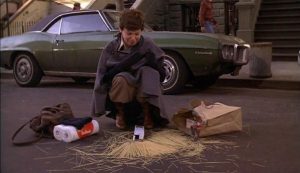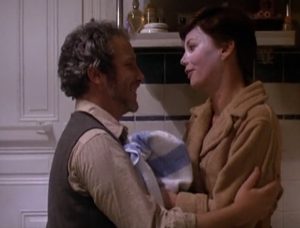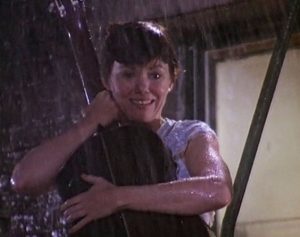 from an Aesthetic Realism seminar, with a discussion of Neil Simon’s 1977 film The Goodbye Girl
from an Aesthetic Realism seminar, with a discussion of Neil Simon’s 1977 film The Goodbye Girl
The summer when I was 19, I went on a vacation to France. I wanted to see Paris at night, and camp out near the beautiful, rough Brittany coast; but my main goal was to fall in love with a romantic Frenchman who would take me away from my mundane Brooklyn existence and adore me. That didn’t happen. And, as time went on, I became increasingly desolate, and so disgusted with myself and with men, I thought I’d be better off if I gave up on love. I’m so grateful that, just weeks after my return, I heard about Aesthetic Realism, and began to learn what love is and what interfered with my having it.
I learned that love is not a separate, cozy realm apart from the world, as I’d thought and many women do. “The purpose of love,” writes Eli Siegel in “Love and Reality,” a chapter of Self and World, “is to feel closely one with things as a whole.” I learned that I needed to see my relation not only to a man, but also to all the people and things I met—my parents, a neighbor, the objects in my room, a book I was reading. And I found out about the thing in myself that interfered with love and my whole life. Mr. Siegel describes it in his lecture Aesthetic Realism and Love:
[People] like to think that the world is bad, disorganized, ugly, that we’re superior to it. We would like to be a god in our own right: that is the victory of contempt. We would also like company; so if we can get somebody out of this world and possess that person, we think we have really pulled a universal fast one.
Aesthetic Realism shows resoundingly that dislike of the world, contempt for it, is the thing that ruins love. I thank Eli Siegel for explaining this, and enabling women—and also men—to criticize contempt in ourselves. This is the most hopeful, cover-story news about love, and is light years away from the hurtful “advice” supplied by many women’s magazines. I’m receiving such a rich education about love and so much more as I attend the exciting, culturally great classes taught by Aesthetic Realism Chairman of Education, Ellen Reiss. What I’ve been learning has made love for a man a reality in my life.
Where the interference begins
Aesthetic Realism teaches that a woman’s attitude to love takes shape long before she goes on a single date: it begins with how she sees the first people she meets. Growing up in Brooklyn, I saw my parents being for and against each other in ways that pained them. Sometimes they had lively, serious conversations. I was affected by how they worked side by side fixing something in our apartment and liked taking long walks along the bay. The time they seemed most for each other was when they were dancing with grace and style to big-band music. But there were also silences, bickering, and often intense arguments—with my father explosively angry, and my mother sarcastic and cool. Each complained to me about the other; I seemed to listen calmly, but I was a politician, liking how important each one made me, while I had contempt for both of them. If this is love, I thought, you can keep it.
For a long time, that’s how I acted. Girls who showed an active interest in boys were silly, I thought, and I mocked boys who liked them when they could have “sensible” me. Meanwhile, I had an ideal picture of love in my mind. In an Aesthetic Realism class a number of years ago, Ellen Reiss described its central ingredient when she asked me, “Would you like to be courted with great reverence?” This was so true. I felt I shouldn’t have to assert myself at all, while a young man would seek me out and say, “I’ve been waiting so long to meet someone just like you—so sensitive, intelligent, wonderful.” Then, it would be in my power to grant the desires of this being I had created. Whenever I actually had to do with a real human being, I felt he couldn’t measure up to my picture, and I was so disdainful, I ended up pushing him away.
For example, when I was 15, and my family went to a hotel in the Catskills, I acted like an aloof princess who felt people should come to me. One day I saw a good-looking young man on the paddleball court. I’d noticed him earlier and wanted to meet him—and here was my chance! He began speaking with my father, then introduced himself to me. I was elated—but, as I spoke, I was so blasé, he left with a shrug. Then I felt very hurt, and thought, miserably: No one will ever care for me. It never occurred to me that my coolness and scorn were not attractive. I also didn’t know, until I began to study Aesthetic Realism, that I had a huge victory of contempt feeling young men were not good enough for me to want to know, and too stupid to see my value.
Many years later, Ms. Reiss so accurately and kindly described how this worked in me. While I had changed very much, there were ways I still held on to a picture of myself as hurt by the world and men. “What would you rather do,” she asked—
say there’s more for you to see [about love], or despair? Despair is a wonderful way of not having to see any more. ‘I know that what I hope for is not going to happen. Other women may be able to speak to a man a certain way, but I know I will never have the chance.’ It’s the same as putting a crown on your head.
This was thrilling to see: that even as I said I wanted love, I also didn’t, because I cherished feeling hurt as a means of feeling scornfully superior to the world. Through this discussion, I knew I could change.
Love is “proud need”
In The Right of Aesthetic Realism to Be Known, #1310, Ellen Reiss describes a crucial way contempt interferes with love:
All over America now, people want to love a person—and yet they don’t want to need a person….And so, people find that they can’t love…: because to have…anyone mean a great deal without needing that…person is impossible.
I based my personality on needing people as little as I could. I hated asking for help with anything. I wasted hours wandering around Macy’s trying to find something, rather than ask where it was. This also showed in how I was with men. I remember vividly many times when I took it as an insult that a man pulled out my chair, or gave me his hand to help me out of a car: after all, did he think I couldn’t do it myself?
But I did want people to need me. I felt this very much with my father, Barney Rosen, whom I wanted to see as needing me more than anyone, including, I am sorry to say, my mother. Meanwhile, I felt I should be able to take or leave him, and it made him furious. I felt that admitting I needed a person was an unbearable humiliation. This is the complete antithesis of love, which Aesthetic Realism defines as “proud need.” When a woman cares for a man, she feels she is proudly asserting herself in yielding to the meaning a man has for her, in saying: “I need you to be myself, because you stand for the world I was born to like.”
I am so glad be learning what real love is, and what interferes with it, in my marriage to Alan Shapiro—jazz pianist and music teacher, whom I respect very much. When we first began speaking, I said in an Aesthetic Realism class that I was afraid of how much feeling I could have for him, and Ellen Reiss asked “Is it good or bad news that a person can have meaning for you?” I said “good news,” but sounded like I didn’t believe it for a minute. Ms. Reiss asked, “How much do you want Mr. Shapiro to be useful to you? Are you scared of it?” I said Yes, and she asked, “Do you think it’s a fear of having more respect?”
It was. In my conceit, I thought I should benefit and instruct him, not get usefulness from him. Fortunately, he objected, pointing out, for instance, with humor, that I sometimes used a patronizing “schoolmarm” voice when I asked him questions about himself, while I tried to edit and arrange very carefully anything I said about myself. I saw it was true, and I felt very relieved. I am happy to say, Alan Shapiro wants to be a deep, critical friend. I’m proud to need his keen perception, his humor, and I’m grateful we’re both studying what it means to use each other to like the world.
A popular film gives evidence for what interferes with love
A film I believe is very useful in seeing how a woman’s desire to dislike the world itself, to get rid of it, interferes with love is the 1977 romantic comedy The Goodbye Girl, written by Neil Simon. And I think a large reason for the popularity of the film, which stars Marsha Mason and Richard Dreyfuss, is that it also gives evidence, delightfully and with some depth, for what Aesthetic Realism alone explains: we want our contempt criticized, opposed; criticism, Eli Siegel showed, is love.
 As the film opens, Paula McFadden, a former Broadway dancer, comes home to find a letter from Tony DeForrest, the actor she and her 10-year-old daughter Lucy have been living with, saying goodbye. Then she finds he has sublet their apartment—really his apartment—to Elliot Garfield, an actor friend from Chicago, without telling her. Furious, and also unemployed, Paula won’t give up the apartment, which has been paid up for the next few months, and refuses to let Elliot in, though the apartment is legally his. But when he sees her difficulty, he generously offers to share it with her.
As the film opens, Paula McFadden, a former Broadway dancer, comes home to find a letter from Tony DeForrest, the actor she and her 10-year-old daughter Lucy have been living with, saying goodbye. Then she finds he has sublet their apartment—really his apartment—to Elliot Garfield, an actor friend from Chicago, without telling her. Furious, and also unemployed, Paula won’t give up the apartment, which has been paid up for the next few months, and refuses to let Elliot in, though the apartment is legally his. But when he sees her difficulty, he generously offers to share it with her.
Paula had done what many women do: she’d wanted to use Tony as a shortcut to liking herself, and so she changed the facts about him to suit this purpose. When she moved in with him, he warned her it wouldn’t be permanent because he was still married. Now, her idyllic world is destroyed, and she angrily gets rid of everything that reminds her of Tony. She feels hurt because, as Mr. Siegel says of a woman in “Love and Reality,” “someone she had constructed to represent…and justify herself, had the boldness to interfere with her arrangements or the architecture of her vanity.”
In a class for which I’m enormously grateful, I spoke about my fear that I might use Alan Shapiro’s and my living together, which we were then planning to do, to have a separate world and get praise for myself. Ms. Reiss explained: “The thing amiss with having a separate world is that you’re having contempt for the world in its fullness.” She asked me to mention something I care for in Mr. Shapiro. I said I liked how he could be serious and also very funny, and Ms. Reiss asked:
Do you think these qualities are elsewhere? If you don’t want to like them any place, do you really like them in a person? If we don’t want to like the way humor and seriousness are in a friend, or a bird, or a street lamp, or something said to our mother, it is not it we like.
In the film, we can see that it was not Tony that Paula was liking; it was some picture of him she was using to love herself, and, as Ellen Reiss writes in The Right of #1183, “of dismissing [the world] in a wash of someone’s adoration of herself.” Meanwhile, she feels the world and men have given her a rotten deal, and so she has a right to be mean. Seeing this, Elliot says, “[You’re] very sharp, a sharp New York girl, right?” “No,” she answers, “a dull Cincinnati kid. But you get dumped on enough, you start to develop an edge.” Paula is determined to be displeased, and wants to see Elliot as just another actor who is going to mess up her life. She tries to intimidate him, rattling off her ground rules in a terse, military manner, and when he objects, Paula is incensed. She gets into bed with her daughter, who asks, “No kiss?” “I’m angry,” she answers, “I don’t want to lose it.”
But Elliot opposes Paula’s bitter cynicism and rigidity, in his down-to-earth good humor, and his desire to have her be sweeter—including through his straight criticism of her—and it has a big effect on her.
Is gratitude necessary for love?
When a person has the world seem friendlier, kinder to us, the natural response is gratitude. But Paula wants the world to serve her, and when it does her some good, to feel it’s simply coming to her, and she doesn’t have to be grateful for a thing.
In one memorable scene, as she and Elliot are walking back from the supermarket, he stops to get wine for their dinner. Just then, several young men jump out of a car, grab Paula’s purse, and speed away. “Aren’t you going to go after them?” she demands of Elliot. In disbelief he says, “After a speeding car?” “Thanks. Thanks a lot,” is her bitter reply. “They could be armed,” he says. “What do you want me to do, fight it out with a can of tomato paste?”
disbelief he says, “After a speeding car?” “Thanks. Thanks a lot,” is her bitter reply. “They could be armed,” he says. “What do you want me to do, fight it out with a can of tomato paste?”
But when Paula points out the car moments later, Elliot does run after it, groceries flying—finally catching up to it at a red light. The men jump out and pull a knife on Elliot and, not surprisingly, he backs down. As the car speeds away, Paula tries to recover her groceries strewn about the street, and put scattered strands of spaghetti back into their box, crying, “I had all my money in there—everything—my last dollar in the world. You and your damned Chianti.”
Elliot: Why can’t you at least thank me for risking my life for you?
Paula: Did you get me my bag back? No. So why should I thank you? Why do I have such lousy luck every time an actor comes into my life?
Paula’s ingratitude is cruel, and Elliot has a right to be hurt, but he doesn’t give up wanting to have a good effect on her. At dinner he is charming and funny as he speaks to her and Lucy, who really likes him. But Paula wants to brood; she is broke and understandably worried, and Elliot kindly offers to pay the living expenses until she gets a job. But since, as I learned from Aesthetic Realism, a person who is determined to feel the world is against her doesn’t want to believe in goodness anywhere, Paula is sure Elliot has some selfish motive. When she asks, “What do you get?,” and he answers, “All you have to do is…be nice to me,” she jumps on this, and twists his really straightforward statement into his implying he wants her to sleep with him. Ordering him to pack up and leave, she storms out of the room. He follows and he is critical:
Would you listen very, very carefully because this may be the last time I’m ever talking to you. Not everybody in this world is after your magnificent body, lady….I don’t even find you that pretty. Maybe if you smile once in a while,
who knows? But I wouldn’t want you to do anything against your religion. And you’re not the only one….who ever got dumped on. I, myself, am a recent dumpee.
He tells her that he is having troubles of his own. A serious actor, he has the lead in an off-Broadway production of a classic play, but the director’s interpretation is so bizarre, Elliot feels it might ruin his career by making him laughing stock. Paula listens; she begins to see how self-absorbed she has been.
“If we are to be true to a friend, or anyone,” writes Eli Siegel, “we must hope to be able to tell him what he may be doing against himself. Criticism, Aesthetic Realism sees, when it has an honest purpose, as a form of love.” Elliot’s criticism is kind—more friendly to her than the adoration she had sought from men—and it affects her deeply. One evening, when her daughter Lucy is sick, Paula asks for his help. Though he is rehearsing, he picks up his guitar, and rushes into the room where Lucy is curled up in pain. As he plays softly, Lucy begins to feel better. For the first time, Paula shows her gratitude for his kindness, and says she is sorry for how she treated him.
Paula is changing how she sees Elliot, and beginning to care for him. But I think that if she had been asked the question Miss Reiss asked me—“Is it good news or bad news that a person can have meaning for you?”—she would have said “bad news.” We can see this in her response when Elliot suddenly kisses her:

I have no time for romance. Please, do not do this to me. Do not make me feel happy. I hate that goddamn, “It’s wonderful to be alive” feeling. Do not come into my life. I just got through putting up fences. I’m praying to God this is all gone in the morning.
Elliot doesn’t believe her: “The hell you are,” he says. But he’s only partly right. She still feels, as so many women do, that the way she will be happy is for a man to make her important, and not, as Aesthetic Realism explains, for her to be just to the world itself, and see a man as standing for that world “different from [her that] can be on [her] side.” And so, when, a month later, she comes home to see Elliot packing—ecstatic at getting a part in a famous director’s film—instead of congratulating him, she feels, as she had when Tony left, that she was wrong to care for him at all. He says, disappointed:
I thought you would be excited. Jumping up and down….I mean, it’s what I’ve worked for my whole life. Isn’t that what a mature relationship is all about? You root for me and I root for you?
What he is asking of Paula, Aesthetic Realism shows, is equivalent to love itself: good will, “the desire that something else be stronger and more beautiful, for this desire makes oneself stronger and more beautiful.” She doesn’t have it, and Elliot is hurt. We cannot love a person who doesn’t have good will for us.
 Meanwhile, she’s very much affected by his criticism, and the film ends on a hopeful note, as, in the final scene, Elliot leaves his most cherished possession, his guitar, with Paula. Seeing this, she knows he will be coming back; she is glad, has more trust in a man, and is less of a “goodbye girl.”
Meanwhile, she’s very much affected by his criticism, and the film ends on a hopeful note, as, in the final scene, Elliot leaves his most cherished possession, his guitar, with Paula. Seeing this, she knows he will be coming back; she is glad, has more trust in a man, and is less of a “goodbye girl.”
The real answer to the question “What, in a woman herself, interferes with love?” is in the study of Aesthetic Realism—a study needed by all the Paulas and Elliots, the women and men of America. “To be able to love any person is a beautiful achievement,” stated Mr. Siegel. “When we are proud of the fact that another person exists and that we have found meaning in him, love is there and is great.” Because of the education of Aesthetic Realism, which enables men and women to see real meaning in the world and each other, we can, at last, learn to have that beautiful achievement: real love!
Find out about the great education that takes place in Aesthetic Realism consultations, from which my life has benefitted so much.
And here are a few issues of The Right of Aesthetic Realism to Be Known which describe a new way of seeing love!
- “What Opposes Love?” by Eli Siegel
- “The Need to Know a Person”
- “The Beauty of Art & the Pain about Love”
And you can read papers by other students and teachers of Aesthetic Realism from public seminars about love, as presented in film: